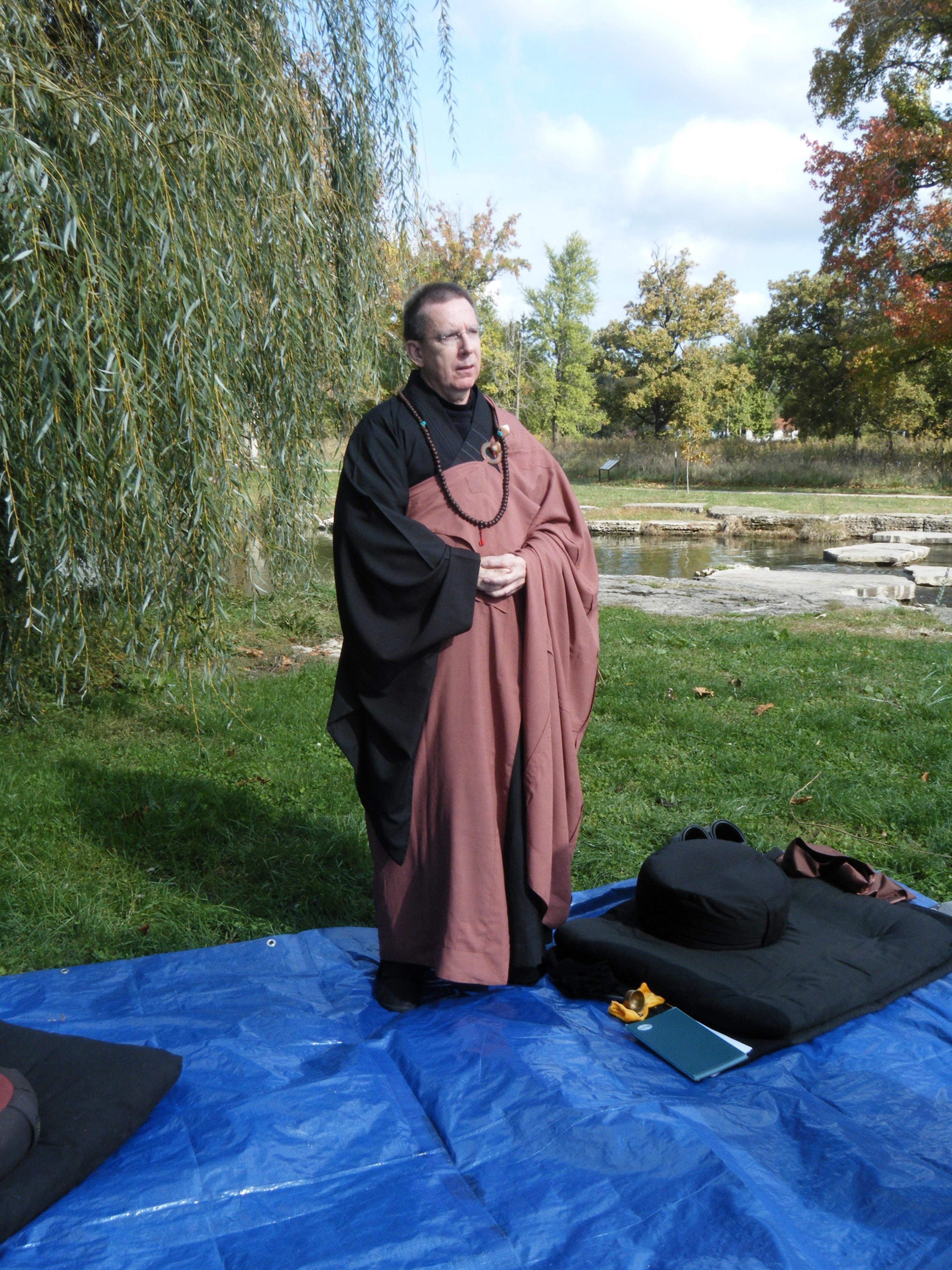By: David Xi-Ken Astor, Sensei
I want to offer you a transparent glimpse of my interfaith perspective gained from my spiritual development as it has unfolded over the years and through my monastic experience both as a Christian and Buddhist monk. It has not always been a clear and concise path and may still remain so. For a true spiritual path has many of the same markers no matter the linage, faith, or set of beliefs.
One of my favorite Christian theologians is Augustine. I still quote him often in my Buddhist discourses and when I wish to authenticate a theological point. While he is one of the old guy’s, his wisdom is as bright today as it was 1700 years ago, at least for me.
With this in mind I want to try to bring Buddhist philosophy and Christian basic theological concepts together by using the philosophical work of Augustine as he writes in “Confessions” & “On Christian Doctrine” compared with “the Middle Length Discourses of the Buddha”. I admit this challenge may be more fitting for those educated in the classical method, but I find the similarities between these two bodies of work to fit into what I wish to convey that shows how either the Christian or Buddhist view can be used to confront some of the most often ask questions for those of us on a spiritual path as there is much in common.
My intent is to get others to think and relate to their beliefs from a philosophical point of view for a moment. As Buddhists we have a practice of meditation and contemplative thought. We have explored some very basic Buddhist themes and have encountered Buddhist thought from a Zen perspective. Now I would like to move on to set a foundation for future philosophical dialog between Christian and Buddhist thought and this approach may be adequate to the task. This is not a Buddhist approach, this is not teaching Buddhism either directly or indirectly; it is establishing, however, the framework so we can learn how others beliefs can directly confront the many challenges we face today in a global society and maybe work together to solves some of these unsatisfactory conditions within our own communities, and in the greater world outside our front door.
Let me present Augustine’s reflections on the interpretation of signs in relation to Buddhist perspectives on language and truth. For Augustine, the interpretation of signs was intimately related to his deciphering of signs of god’s love in the narrative of his own life. While in many ways Augustine’s perspectives conflict sharply with Buddhist principles, the play of similarity and difference can be illuminating for both traditions, if we keep an open mind.
As you may have already learned from my earlier writings that contemporary study of Buddhism is sensitive to the inadequacy of language to express ultimate truth and considers all doctrines to be skillful means. Buddhism is a vehicle for anyone to awaken to how the Universe is in reality. I no longer talk about ultimate “truth.” We need to be very, very careful when we, as humans, try to define the unknowable. Augustine was also acutely aware that his use of language cannot express ultimate reality, and he developed a sophisticated and influential theory of signs in order to clarify the task of preaching and teaching the Christian ideal.
To understand the meaning of his own life, both his past wanderings and as a functioning bishop, Augustine found that he had to learn to decipher a variety of signs: the signs of the scriptures, the signs of others behavior, the signs of fortuitous events, and the signs of his own moods and feelings. (early consideration of how the body/mind interact). In deciphering these signs he had to learn to discern which revealed his notion of the will of god.
For Augustine, the interpretation of signs is crucial to following the path of the Christian life. One’s immediate understanding of themselves and their world is systematically distorted by sin, which prevents them from seeing the signs of god’s love around them, he would say. If they misinterpret signs, they inevitably misread the meaning of their emotions, as well as the true significance of the persons and objects around them. Deceived in one’s self-understanding, they misdirect their energies and desires, making some finite object their ultimate goal. He wrote that knowing how to interpret signs offers one the key to knowing themselves, to seeing the temptations that can deceive, to deciphering the activity of god in ones life, and to finding the true path to wisdom and happiness. For Augustine, knowledge of self and knowledge of god are inseparable, but one only knows god and themselves through the interpretation of signs.
“On Christian Doctrine” is an educational handbook to instruct Christian teachers to interpret signs properly so that they in turn can lead the entire Christian community. The work sets forth a system of Christian eloquence and rhetoric, a way of interpreting the scriptures to clarify the meaning of human existence. To accomplish this end, it also offers a theory of language to clarify the way one speaks of god and human existence. Throughout this work Augustine assumes that the signs of the Bible come from god and are god’s gracious gifts to illumine a spiritual path.
For Augustine, one can never directly describe the reality of god. The incomprehensibility of god is a basic principle that guides all interpretations of language about god. This is often where the more serious dialog takes place between Christian and Buddhist traditions.
Buddhism is a philosophy first and foremost, but has survived over the centuries because of its practice as a religion. The beauty of Buddhism is precisely that it is not exclusive or rarefied; much of what Buddhist thought is showing us is exactly what people throughout the centuries have experienced, whether they call themselves Jewish, Christian, Muslim or nothing at all. Gandhi himself a Hindu and sometimes described as a “Christian Mohammedan” said that his mission was not to deliver people from difficult situations but, rather, to show that every man or woman, however weak in body, is the guardian of his or her self respect and liberty. To call these truths Buddhist is as strange as calling the law of gravity Christian just because it happened to have been formulated by the Christian named Isaac Newton.
The Gospels, revealingly, tell us little of Jesus’ spiritual formation and concentrate mostly on his words and actions. The Buddha’s story by comparison, places most of its emphasis on how Siddhartha came to enlightenment – the process which anyone can follow, even today in principle – while the particular details of his subsequent teachings and wanderings are often barely mentioned, unless one has dedicated themselves to a formal training practice. Even non-Christians may know some of Jesus’ words, while typical lay Buddhists may know hardly any of Buddha’s specific discourses or the legacy canon . One reason maybe that they are difficult to study. Buddha is a precedent more than a prophet; and where Jesus came to earth as the “way, the truth, and the life,” the Buddha came to teach that in order to eliminate unsatisfactoriness we need to search our inner being to find something changeless within. (the not-self) While language is important for us to know something, signs as Augustan speaks of them take on a different meaning for a Buddhist as we look within ourselves for the “signs” that teach us what is necessary to subtract from our set of behaviors in order to move away from suffering and towards a life of flourishing. But like what Augustan also came to understand, awakened moments are triggered by events outside the ordinary when realized by the mental state of the extra-ordinary. We are challenged to go beyond the words used to express thoughts, to find the lessons to be found between them. Christians and Buddhist may use different words, and use words like “signs” to express a meaning, but what is being pointed at ought to be the same if they point to universal realities. Yes, there is very big differences, especially when we bring in the language of how to consider the creation process. But Jesus and Siddhartha spoke about the same themes over and over again: the theme of social justice and human values that promote the good and how to avoid harm. In other words, the human condition.
I would like to encourage my readers to use this lesson for thoughtful contemplation by relating your own spiritual experiences, past reading and social interactions to add to the body of understanding you are obtaining as you seek a path “up the mountain.”


















































































